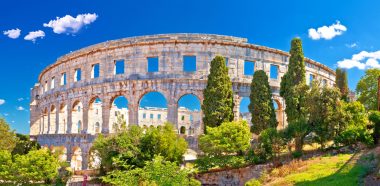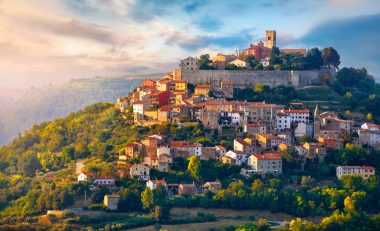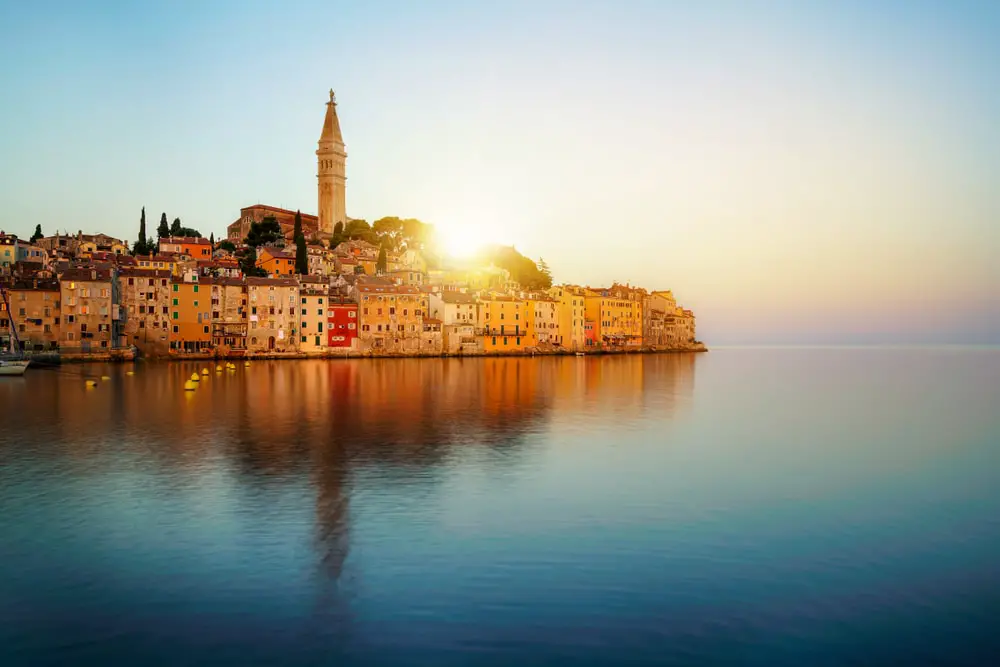Istria is a fascinating region on the Mediterranean Adriatic Sea. The prominent peninsula belongs to Croatia to a large extent. In addition to Croatia, however, Slovenia and to a small extent (especially the region around Muggia) also Italy share the fascinating country of the peninsula.
Along with Dalmatia, Istria is one of the most beautiful holiday regions in Croatia. Located in the north of the country, idyllic bathing bays, some millennia-old sights and a fascinating mixture of nature and culture await you here, which make the north of Croatia so special.
The cultural and natural beauty of Istria

The Mediterranean surf of the Adriatic Sea washes around the partly picturesque coasts of Istria. The peninsula in the north of Croatia has a long history that dates far back to ancient times and beyond. Istria owes its name to the ancient Histrians who once settled in the region – and were incorporated into the Roman Empire around 177 BC. This is one of the reasons why cultural remnants of Roman rule can still be discovered in Istria today.
A highlight: the world-famous amphitheatre in Pula. Built under the Roman Emperor Augustus, the building was later considered the sixth largest amphitheater of antiquity – and still today as a cultural highlight of Istria. So if you want to see a first-class Roman amphitheater, you don’t have to travel to Rome . Istria itself has some special cultural treasures from Roman times – and far beyond.
But Istria is more than a cultural hotspot in the north of Croatia. Dreamlike Mediterranean landscapes with over 500 km of coastline – including idyllic bays and untouched natural scenery – characterise the Istrian peninsula. The beauty of the local nature can be discovered, for example, in the popular Brijuni National Park. The special nature area, which extends on the archipelago of the same name off the coast of Istria, measures about 35 km².
The only national park in Istria consists of two large and twelve smaller island formations that form Brijuni. It is here that the fascinating proximity of culture and nature that makes Istria so special becomes apparent. There is not only the Brijuni Saline bird reserve and the Veli Brijun safari park, but also historical memorials such as the ruins of a temple of Venus or a Byzantine fort in the midst of idyllic natural scenery. And dinosaur prints on the beach are reminiscent of completely different prehistoric times. Excursion boats regularly take you to the special natural region in the waters of the Adriatic Sea. And that’s not all idyllic nature: Cape Kamenjak is located in the absolute south of Istria, not far from the picturesque holiday resort of Premantura. There are about 30 bays here, some of which have fantastic beach sections, which can turn your dream holiday by the Mediterranean sea into an unforgettable reality.
Urban sights in the picturesque north of Croatia
But it’s not just beaches and important historical sights that can be discovered on the coasts of Istria – urban and village life in the region is also flourishing here. One of the settlements on the Istrian coast that is worth visiting is Rovinj. Almost 15,000 inhabitants live in the city, which is located on the west coast of Istria. It is known for its numerous important sacred buildings, including the Church of St. Euphemia from the 18th century.

The city is also known for its picturesque scenery steeped in history, which attracts tourists from all over the world. The municipality of Motovun, which is located in the north-west of Istria, is much smaller. However, with its rich history, the home of about 1000 inhabitants is considered one of the most fascinating places in Istria. Motovun was already known as Montana in Roman times. Today, Motovun is known for its scenic townscape and extraordinary architecture, which was built under Venetian rule. On a prominent hill, the historic settlement rises above the green surrounding countryside, surrounded by historic masonry, some of whose origins date back to the 13th century. If you are interested in the history of medieval Istria, Motovun should not be missed.
But that’s not all with the fascinating settlements of Istria. Pula has already been mentioned as home to one of the most important amphitheatres in Roman history. But the city of 57,000 inhabitants, whose landmark includes the central amphitheater, has even more historical treasures to offer than sights. These include the ancient Arch of Sergian, built between 29 and 27 BC, which is intended to commemorate Octavian’s victory in the Battle of Actium. In addition, the city, which is located on the seafront of southern Istria, also has a historic Temple of Augustus from ancient times. Hum in the north of the region, which is considered the “smallest city in the world”, is also popular with tourists. With only about 30 inhabitants, it is an extremely small settlement, but it looks back on a pronounced early Christian history and has important historical walls.
Reasons to travel to Istria
By the way, Istria has a strong culinary culture. Whether spicy Istrian prosciutto, Mediterranean seafood and fish dishes or pasta – Istria also presents its cultural diversity, which has developed over thousands of years of different influences, on the plate. If you want to discover the Mediterranean side of Croatia and have a special fascination for ancient history, you should not miss Istria, which offers a very special trip with idyllic bays, Mediterranean beaches, untouched natural scenery and historical cultural heritage.


